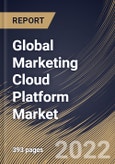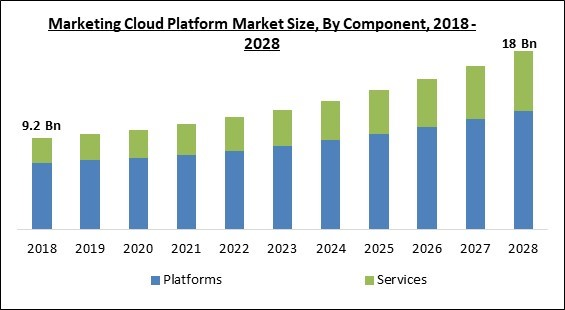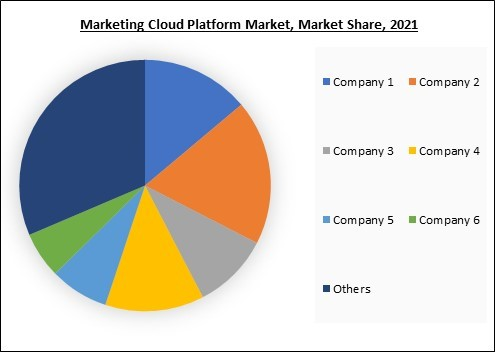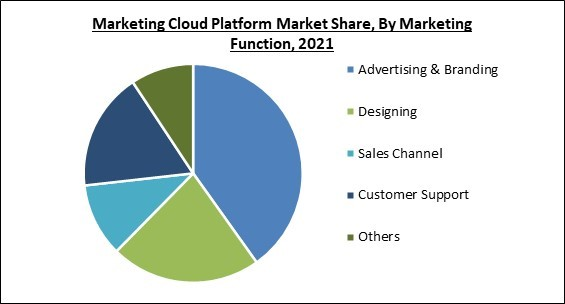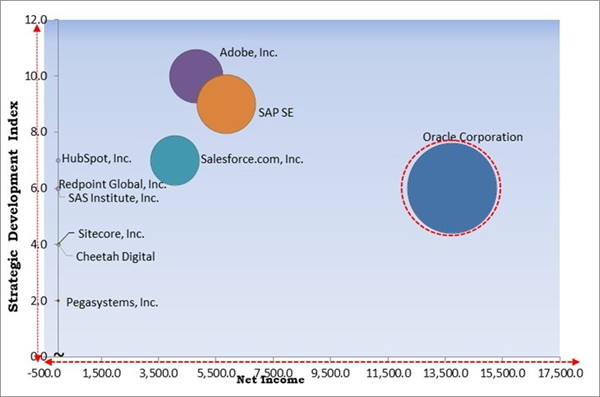The Global Marketing Cloud Platform Market size is expected to reach $18 billion by 2028, rising at a market growth of 8.0% CAGR during the forecast period.
The marketing Cloud platform provides relevant, personalized journeys across channels and devices, enabling marketers to deliver the appropriate message at the appropriate moment across all phases of the relationship. Marketing Cloud provides tools for customer experience management, mobile, email, social, site personalization, advertising, content production, managerial staff, and data analysis. Covering every possible customer touch and engagement, and guiding consumers on their 1-to-1 journeys with business has never been simpler or more effective.
Marketing clouds are a set of marketing solutions that are all delivered via the cloud and allow marketers to manage client interactions and marketing campaigns more. Marketing cloud platforms are aimed to simplify real-time monitoring, planning, and decision-making as part of the broader trend toward marketing automation. As expected, a marketing cloud offers a complete digital marketing platform with a wide range of features and solutions.
Social media, content production, web personalization, content management, data analysis, and advertising are included. The purpose of a cloud platform is to handle marketing efforts more. With the marketing cloud, businesses can furthermore employ event-driven triggers to set in motion particular responses to consumer behaviors.
For instance, if a customer enrolls in a loyalty program, marketing clouds can automatically send each of them thank-you letters via push notifications. The overall objective of the marketing cloud is to enable marketers to develop cohesive multiple-channel experiences, reaching custom through the proper channels - including SMS, social media, MMS, and messaging (along with group messaging) - at the appropriate moments, thereby increasing sales and revenue.
The leading players in the market are competing with diverse innovative offerings to remain competitive in the market. The below illustration shows the percentage of revenue shared by some of the leading companies in the market. The leading players of the market are adopting various strategies in order to cater demand coming from the different industries. The key developmental strategies in the market are Acquisitions, and Product Launches.
The major strategies followed by the market participants are Acquisitions and Product Launches. Based on the Analysis presented in the Cardinal matrix; Oracle Corporation is the major forerunners in the Marketing Cloud Platform Market. Companies such as Adobe, Inc., Salesforce.com, Inc., SAP SE are some of the key innovators in Marketing Cloud Platform Market.
The market research report covers the analysis of key stake holders of the market. Key companies profiled in the report include Adobe, Inc., Salesforce.com, Inc., Oracle Corporation, Pegasystems, Inc., HubSpot, Inc., SAP SE, SAS Institute, Inc., Redpoint Global, Inc., Cheetah Digital and Sitecore, Inc.
The marketing Cloud platform provides relevant, personalized journeys across channels and devices, enabling marketers to deliver the appropriate message at the appropriate moment across all phases of the relationship. Marketing Cloud provides tools for customer experience management, mobile, email, social, site personalization, advertising, content production, managerial staff, and data analysis. Covering every possible customer touch and engagement, and guiding consumers on their 1-to-1 journeys with business has never been simpler or more effective.
Marketing clouds are a set of marketing solutions that are all delivered via the cloud and allow marketers to manage client interactions and marketing campaigns more. Marketing cloud platforms are aimed to simplify real-time monitoring, planning, and decision-making as part of the broader trend toward marketing automation. As expected, a marketing cloud offers a complete digital marketing platform with a wide range of features and solutions.
Social media, content production, web personalization, content management, data analysis, and advertising are included. The purpose of a cloud platform is to handle marketing efforts more. With the marketing cloud, businesses can furthermore employ event-driven triggers to set in motion particular responses to consumer behaviors.
For instance, if a customer enrolls in a loyalty program, marketing clouds can automatically send each of them thank-you letters via push notifications. The overall objective of the marketing cloud is to enable marketers to develop cohesive multiple-channel experiences, reaching custom through the proper channels - including SMS, social media, MMS, and messaging (along with group messaging) - at the appropriate moments, thereby increasing sales and revenue.
The leading players in the market are competing with diverse innovative offerings to remain competitive in the market. The below illustration shows the percentage of revenue shared by some of the leading companies in the market. The leading players of the market are adopting various strategies in order to cater demand coming from the different industries. The key developmental strategies in the market are Acquisitions, and Product Launches.
COVID-19 Impact Analysis
COVID-19 has had a substantial effect on the company's competitiveness due to the restrictions placed on communications with current and potential customers. In any industry, the customer is the major focus of enterprises. Consequently, businesses will gain from the relationships that marketers have created with their clients over time throughout the COVID-19 pandemic. The marketing cloud platform enables organizations to evaluate client interactions all through the lifecycle of a product or consumer. The pandemic has compelled organizations to rely increasingly on advertising cloud platforms to rethink corporate operations, customer relationships, and marketing strategies. During the pandemic, both individuals and businesses turned toward automated systems and were dependent on cloud-based technology, increasing in demand for marketing cloud platform services.Market Growth Factors
Augmentation of The Consumer Data Platform to Enhance the Marketing Experience
The customer data platform (CDP) enables marketers to provide uniform customer experiences through websites, email, mobile, social media, advertising, and offline channels. By creating a consistent, tailored omnichannel experience, marketers can keep customers engaged and moving forward toward their journeys. A platform with extensibility can develop and evolve to meet the market's demands without having to be completely rewritten. A flexible platform makes it easy to incorporate new products and services to accommodate fluctuating demands across several platforms.Digital Participation Via Virtual Reality (Vr) And Augmented Reality
Virtual Reality (VR) and Augmented Reality (AR) have been widely adopted in the gaming sector, and these cutting-edge technologies are currently being utilized in digital marketing to increase company. Vertical industries, such as media, entertainment, gaming; retail; and education, are deliberately investing in and integrating VR and AR technologies to enhance customer experiences. AR combines the actual and digital worlds by superimposing a digitally generated overlay onto the current environment, whereas VR refers to an entirely digital reality. Creating a lasting impression, campaigns utilizing AR and VR technology provide the audience with a greater sense of the products and services.Marketing Restraining Factor
Increased Lock-In of Vendors
It is known as vendor lock-in when a customer's commitment to a single service supplier makes switching practically impossible. Consequently, the client's reliance on the service supplier increases. Lock-in is an issue with cloud marketing platforms. This dependency emerges as a result of the effort required to switch providers, which may make this a poor option or seem impossible. Vendor lock-in happens when a single vendor dominates the technology, binding the consumer to that company.Component Outlook
Based on the Component, the Marketing Cloud Platform Market is segmented into Platforms and Services. The platforms segment acquired the highest revenue share in the marketing cloud platform market in 2021. A combination of marketing technology that marketers can access over the web, as opposed to on-premise solutions. Typically, a cloud marketing platform will contain tools for managing programs, creating content, scheduling tasks, engaging customers through social networks, and managing analytics and reporting to optimize marketing efforts.Platforms Type Outlook
On the basis of Platforms Type, the Marketing Cloud Platform Market is divided into Customer Relationship Management, Software-as-a-Service, and Business-to-Business. The software-as-a-service segment procured the largest revenue share in the marketing cloud platform market in 2021. SaaS is considered part of cloud computing. It is because users often access SaaS applications using a thin client, such as a web browser. SaaS has become a prevalent delivery model for numerous business applications, such as office applications, messaging software, payroll management software, DBMS software, management software.Marketing Function Outlook
On the basis of Marketing Function, the Marketing Cloud Platform Market is segmented into Advertising & branding, Designing, Sales Channels, and Customer Support and others. The customer support segment recorded a significant revenue share in the marketing cloud platform market in 2021. Customer support is a collection of services designed to aid customers in the efficient and proper usage of a product. It consists of assistance with product planning, implementation, teaching, troubleshooting, upkeep, upgrading, and disposal.Deployment Outlook
Based on the Deployment Mode, the Marketing Cloud Platform Market is bifurcated into Public Cloud and Private Cloud. The public cloud segment acquired the largest revenue share in the marketing cloud platform market in 2021. Public Cloud is an information technology approach in which on-demand computing resources and infrastructure are maintained by a third-party provider and shared with many companies over the Internet.Organization Size Outlook
By Organization Size, the Marketing Cloud Platform Market is classified into Large Enterprises and SMEs. The SMEs segment registered a significant revenue share in the marketing cloud platform market in 2021. It is because it provides excellent automation tools for small enterprises. Salesforce's pricing is accessible to nearly everyone and may be utilized to launch a small business. Salesforce propels businesses to new heights and provides new areas for exploration.Vertical Outlook
Based on the Verticals, the Marketing Cloud Platform Market is bifurcated into Retail & eCommerce, Banking, Financial Services, & Insurance (BFSI), IT & Telecom, Education, Travel & Hospitality, Media, Entertainment, & Gaming, Healthcare & Life Sciences, and Other. The media, entertainment, and gaming segment witnessed a promising growth rate in the marketing cloud platform market in 2021. The media, entertainment, and gaming industry have experienced a transition to adapt their business operations and how content is created, controlled, and distributed to the digital era.Regional Outlook
Region-wise, the Marketing Cloud Platform Market is analyzed across North America, Europe, Asia Pacific, and LAMEA. The North America segment acquired the highest revenue share in the marketing cloud platform market in 2021. It is because North American nations such as the United States and Canada have a robust economic landscape, enormous IT budgets, high technology assimilation, and early adoption of advanced technologies such as artificial intelligence, machine learning, cybersecurity, data analytics, and blockchain, all of which are anticipated to increase the demand for marketing cloud platforms among North American businesses.The Cardinal Matrix - Marketing Cloud Platform Market Competition Analysis
The major strategies followed by the market participants are Acquisitions and Product Launches. Based on the Analysis presented in the Cardinal matrix; Oracle Corporation is the major forerunners in the Marketing Cloud Platform Market. Companies such as Adobe, Inc., Salesforce.com, Inc., SAP SE are some of the key innovators in Marketing Cloud Platform Market.
The market research report covers the analysis of key stake holders of the market. Key companies profiled in the report include Adobe, Inc., Salesforce.com, Inc., Oracle Corporation, Pegasystems, Inc., HubSpot, Inc., SAP SE, SAS Institute, Inc., Redpoint Global, Inc., Cheetah Digital and Sitecore, Inc.
Strategies Deployed in Marketing Cloud Platform Market
Partnerships, Collaborations and Agreements:
- May-2022: SAP came into a partnership with Accenture, an Irish American professional services company. Together, the companies aimed to introduce a new joint portfolio to assist large companies to move to the cloud and provide continuous innovation. Moreover, the new joint portfolio integrates the RISE with an SAP solution and SOAR with Accenture services offering and has been enhanced with new features that contain Accenture’s complete suite of transformation services, such as customized cloud services and proprietary intelligent tools, offered through a cohesive as-a-service model.
- Mar-2022: Pegasystems came into a partnership with Google Cloud, a suite of cloud computing services. This partnership would help mutual customers to boost their digital modifications with Pega’s low-code business software on Google Cloud’s favorably reliable cloud services. Additionally, Pega would create Pega Cloud applications available on Google Cloud as a completely hosted and managed-as-a-service portfolio. Moreover, the partnership permits customers to decide how they want to implement Pega, delivering the selection, flexibility, and asset to configure their cloud environment to best suit their requirements and adjust to business changes.
- Sep-2021: SAS came into a partnership with Microsoft Azure, a cloud computing service. Through this partnership, the implementation of SAS Cloud in the Azure Central India region in Pune brings the total number of Azure regions reinforced by SAS Cloud to 11, with locations across the US, UK, Germany, Australia, and Brazil, supported by future rollouts across the globe. Moreover, Microsoft and the significant local investment allow the company to further reinforce its commitment to consumers by delivering a broad choice of data processing locations to serve legal and company conditions.
- Aug-2021: HubSpot came into a partnership with Envato, the world-leading online gathering for creative tools, assets, and talent. Together, the companies aimed to introduce more than 250 high-quality and various website themes on Envato Market, all created particularly for the HubSpot CMS Hub. Additionally, adding a CMS Hub variety on ThemeForest, makes it even more pleasing for scaling businesses for utilizing cloud-based CMS to get started fast and provide incredible digital experiences to their consumers.
Acquisition & Mergers:
- May-2021: Sitecore took over Moosend, a SaaS-based marketing automation platform provider. This acquisition would complete Sitecore’s capability to power the personalization conditions of trendy enterprises, with the combination of Moosend’s cloud-native, API-first, and modular marketing automation medium. Moreover, Sitecore’s development to evolve into a SaaS-based digital experience platform is competent of helping the most refined digital experiences.
- Jan-2021: SAS completed the acquisition of Boemska, a privately held technology company. This acquisition would improve SAS Viya, a cloud-native, advanced analytics platform with a rich set of abilities that promote SAS’ goal of sustaining the complete analytics life cycle and promoting customer migration to the cloud. Moreover, Boemska’s technology puts SAS closer to where judgments are created and unrestricted in cloud marketplaces for applications inventors.
- Dec-2020: Adobe took over Workfront, the dominant work management platform. This acquisition would bring efficiency, cooperation, and productivity advancements to marketing teams currently contested with siloed work administration solutions.
- Oct-2020: SAP took over Emarsys, a supreme omnichannel consumer engagement platform provider. The new Emarsys allows businesses to engage more productively and more personally with their consumers. Additionally, improving the SAP Customer Experience offering with Emarsys would form a new paradigm for how business is managed digitally as it would deliver omnichannel engagements in real time, hyper personalized, allowing companies to ensure every engagement is appropriate and impactful.
Product Launches and Product Expansions:
- Feb-2022: Salesforce introduced Safety Cloud, assisting people to get together safely. The Safety Cloud helps communities and companies better manage health, testing, and entry protocols to develop securer in-person experiences on occasion and in the workplace.
- Sep-2021: Oracle launched Oracle Fusion Marketing, helping marketers manage campaigns that develop highly qualified sales possibilities. This launch allows marketers to efficiently create campaigns that traverse traditional advertising and marketing channels and is the first marketing automation solution that is designed to bypass the entire lead conversion and qualification procedure. Moreover, Fusion Marketing uses artificial intelligence (AI) to automatically score tips at the account level, except when customers are inclined to talk to a salesperson and develop a qualified sales prospect in any CRM strategy.
- Jul-2021: Redpoint launched In Situ the foremost cloud-native, data quality-as-a-service. The In Situ delivers unified consumer data in place, at unprecedented comfort, pace, and scale without the need to transfer data across the internet. Moreover, In Situ also delivers radical transparency into the reliability, quality, and trust of all consumer data authorizing companies to confidently implement their data across all edge points of the company.
- Apr-2021: HubSpot introduced Operations Hub. The product is developed to transform the role of procedures experts across the enterprise and certify them to take center stage in supporting their company's scale. Moreover, with Operations Hub, customers can unify consumer data in a connected CRM platform, automate a host of time-consuming jobs, maintain a clean database with comfort, and ultimately, play an active part in creating their organization's strategy.
- Oct-2020: SAP introduced SAP Customer Data Platform, a next-generation consumer data platform. The SAP customer data platform permits institutions to reimagine the consumer experience across every engagement, from business and marketing to service and sales. Moreover, the SAP Customer Data Platform is planned to go further in marketing by adding rich context to sales, commerce, and service experiences, with relevant convenient marketing.
- Sep-2020: Oracle launched a series of innovations within its customer data platform. The series would allow marketers to streamline the delivery of personalized marketing schedules that boost sales, enhance consumer fulfillment, and grow consumer lifetime value. Furthermore, the latest updates to Oracle Unity allow B2B and B2C marketers to stop expensive and complicated consumer data integration projects by delivering a single platform that unifies all consumer data and allows it to be rapidly and easily activated within living business operations.
Scope of the Study
By Component
- Platforms
- Software-as-a-service
- Customer Relationship Management
- Business-to-Business
- Services
By Marketing Function
- Advertising & Branding
- Designing
- Sales Channel
- Customer Support
- Others
By Deployment Mode
- Public
- Private
By Organization Size
- Large Enterprises
- Small & Medium Enterprises (SMEs)
By Vertical
- Retail & eCommerce
- BFSI
- IT & Telecom
- Education
- Travel & Hospitality
- Media, Entertainment, & Gaming
- Healthcare & Life Sciences
- Others
By Geography
- North America
- US
- Canada
- Mexico
- Rest of North America
- Europe
- Germany
- UK
- France
- Russia
- Spain
- Italy
- Rest of Europe
- Asia Pacific
- China
- Japan
- India
- South Korea
- Singapore
- Malaysia
- Rest of Asia Pacific
- LAMEA
- Brazil
- Argentina
- UAE
- Saudi Arabia
- South Africa
- Nigeria
- Rest of LAMEA
Key Market Players
List of Companies Profiled in the Report:
- Adobe, Inc.
- Salesforce.com, Inc.
- Oracle Corporation
- Pegasystems, Inc.
- HubSpot, Inc.
- SAP SE
- SAS Institute, Inc.
- Redpoint Global, Inc.
- Cheetah Digital
- Sitecore, Inc.
Unique Offerings
- Exhaustive coverage
- The highest number of market tables and figures
- Subscription-based model available
- Guaranteed best price
- Assured post sales research support with 10% customization free
Table of Contents
Chapter 1. Market Scope & Methodology
Chapter 2. Market Overview
Chapter 3. Competition Analysis - Global
Chapter 4. Global Marketing Cloud Platform Market by Component
Chapter 5. Global Marketing Cloud Platform Market by Marketing Function
Chapter 6. Global Marketing Cloud Platform Market by Deployment Mode
Chapter 7. Global Marketing Cloud Platform Market by Organization Size
Chapter 8. Global Marketing Cloud Platform Market by Vertical
Chapter 9. Global Marketing Cloud Platform Market by Region
Chapter 10. Company Profiles
Companies Mentioned
- Adobe, Inc.
- Salesforce.com, Inc.
- Oracle Corporation
- Pegasystems, Inc.
- HubSpot, Inc.
- SAP SE
- SAS Institute, Inc.
- Redpoint Global, Inc.
- Cheetah Digital
- Sitecore, Inc.
Methodology

LOADING...
Table Information
| Report Attribute | Details |
|---|---|
| No. of Pages | 393 |
| Published | October 2022 |
| Forecast Period | 2021 - 2028 |
| Estimated Market Value ( USD | $ 10605 Million |
| Forecasted Market Value ( USD | $ 17980 Million |
| Compound Annual Growth Rate | 8.0% |
| Regions Covered | Global |
| No. of Companies Mentioned | 10 |


